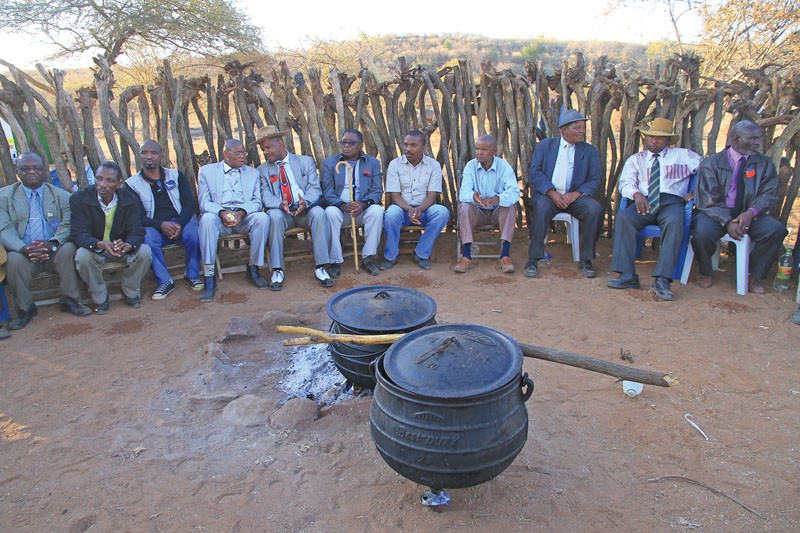Deconstructing Dithubaruba
Thalefang Charles | Friday September 2, 2016 15:05


After 164 years of Kgosi Sechele’s strategic retreat from Dimawe to Dithejwane Hills, on this 50th year of Botswana’s independence and 10 years of Dithubaruba Cultural Festival, five Bakwena tribesmen namely Kgosi Keineetse Sebele, Barolong Seboni, Seratwa Ntloedibe, Titus Mbuya and Geoffrey Barei took to the podium to pay homage to Kgosi Sechele’s often overlooked significance on the formation of Botswana by examining Dithubaruba.
Dithubaruba, an area situated at Dithejwane Hills west of Molepolole, was the capital of Bakwena from around 1853 to 1863 before they relocated to Ntsweng in Molepolole. The place, which sometimes is referred to as Seokomedi, according to Ntloedibe, has been described as the birthplace of modern day Botswana.
“Dithubaruba is the ancestral home of Botswana,” Barei, a lecturer at UB summed it up. Barei was presenting under the topic, ‘Dithubaruba, nation-building model’. He said that according to historical accounts almost all the tribes from southern Botswana have a connection with Dithubaruba.
Barei added onto the history of Dithubaruba that was presented by Kgosi Sebele who focused on the lineage and timeline (albeit disjointed) of his great grandfather Kgosi Sechele I together with his migrations from Sokwane to Dimawe and Dithubaruba to Ntsweng.
Kgosi Sebele had traced Sechele I’s family tree saying he was the son of Motswasele II, son of Legwale, son of Motswasele I, son of Motshodi, son of Tebele, son of Kgabo I, son of Phoketsa, son of Kwena, son of Malope and son of Masilo.
Kgosi Sebele recounted the tribulations of Sechele after the brutal murder of his father and his wanderings before eventually assuming Bakwena chieftaincy. He told of Sechele building his morafe by uniting the Bakwena clans of Segotlotlo, Tshosa and Moruakgomo.
He started the nation-building at Dimawe where he was joined by Bakgatla Ba Ga Mmanaana, Bakaa Ba Ga Thobela and Bahurutshe Ba Ga Mangope. Sechele was first attacked by the Boers at Dimawe where Mangope was killed at Boswelakgosi.
After the Battle of Dimawe, which Sechele successfully managed to defend despite suffering some causalities, he retreated to Dithejwane Hills. The Boers launched their second attack against Sechele at Dithejwane and once again, Bakwena stood their ground and that is how the place earned its new name Dithubaruba.
Barei noted how the Dithejwane Hills were a ”heavily fortified, strategic and economically viable” location where Bakwena thrived. He said after the migration from Dimawe to Dithubaruba there was influx of Tswana groups including Bakgatla, Balete, Bahurutshe and Batlokwa who sought refuge from Sechele against the common enemy that was the Boers. Barei said at some point the population of Dithubaruba is believed to have been over 25,000 from Dimawe’s estimated 4,000 people.
It is said that Sechele adopted the style of leadership where all the various groups under him maintained their autonomy.
Although it created much infighting within the groups, especially over leadership, it maintained each group’s identity. This is why later these groups managed to relocate around Sechele’s land and spread across Tswana land.
Barei posited that Dithubaruba was the foundation of Botswana because almost all the tribes around Kweneng continued their allegiance to Dithubaruba even after they relocated away from the place.
Dithubaruba was abandoned after diseases, notably cattle lung diseases and Malaria, hit. Sechele moved to Ntsweng at present day Molepolole.
Ntloedibe examined the theology of Sechele and how it impacted on his nation-building. She presented that Sechele was first a notable rain-maker who curiously adopted the new religion of the white man despite his people’s disapproval.
Ntloedibe says Sechele was a product of an orchestrated scheme to prove the excellence of Christianity as a religion. She told how Sechele first met missionaries from the London Missionary Society (LMS) and the German Hermannsburg Mission (GHM).
Sechele is famously described as the only convert of the Scottish missionary David Livingstone of LMS who lived among Bakwena before he started exploring further into central Africa. Ntloedibe noted that Sechele accepted Christianity but explained to his teacher, Livingstone that before the new religion, they were not actually lost because they were only “told differently”. She says these words by Sechele explain the unique approach of African Christian practices.
Despite sliding back a few times, Sechele later became the first prominent African missionary who spread the Christian beliefs across the Kgalagadi desert to the Ndebele land at present day Zimbabwe. Christianity was a dominant belief at Dithubaruba, even after Livingstone abandoned Bakwena. Sechele invited the GHM (Lutheran Church) to continue the gospel and that explains why Christianity became prevalent in Botswana.
Poet and playwright, Seboni made a presentation on how the history of Sechele inspired creative arts using his play titled Sechele I as an example. He said Jeff Ramsay’s dissertation and David Magang’s autobiography, The Magic Of Perseverance have rich historical accounts of Sechele and Bakwena that need to be studied.
Veteran journalist and Mmegi managing director, Mbuya focused his presentation on local media’s reporting on cultural issues. Mbuya said, “Humans learn their culture through their own language, but our society has failed to develop indigenous languages in order to properly teach about culture”.
He said although the media covers culture they could not communicate its various aspects if they do not use the indigenous languages. He implored the government to invest in improving indigenous languages and urged educational institutions to transform their curriculum so that they could produce journalists that understand reporting on culture and identity.
The issue of Botswana’s failure to tell its stories was shared by the audience during the comments section. Many called on the productions of literary works to preserve Botswana history.
Tonight there would be an oral history night at the Molepolole Main Kgotla while the main Dithubaruba Cultural Festival will be held tomorrow at Ntsweng in Molepolole.
